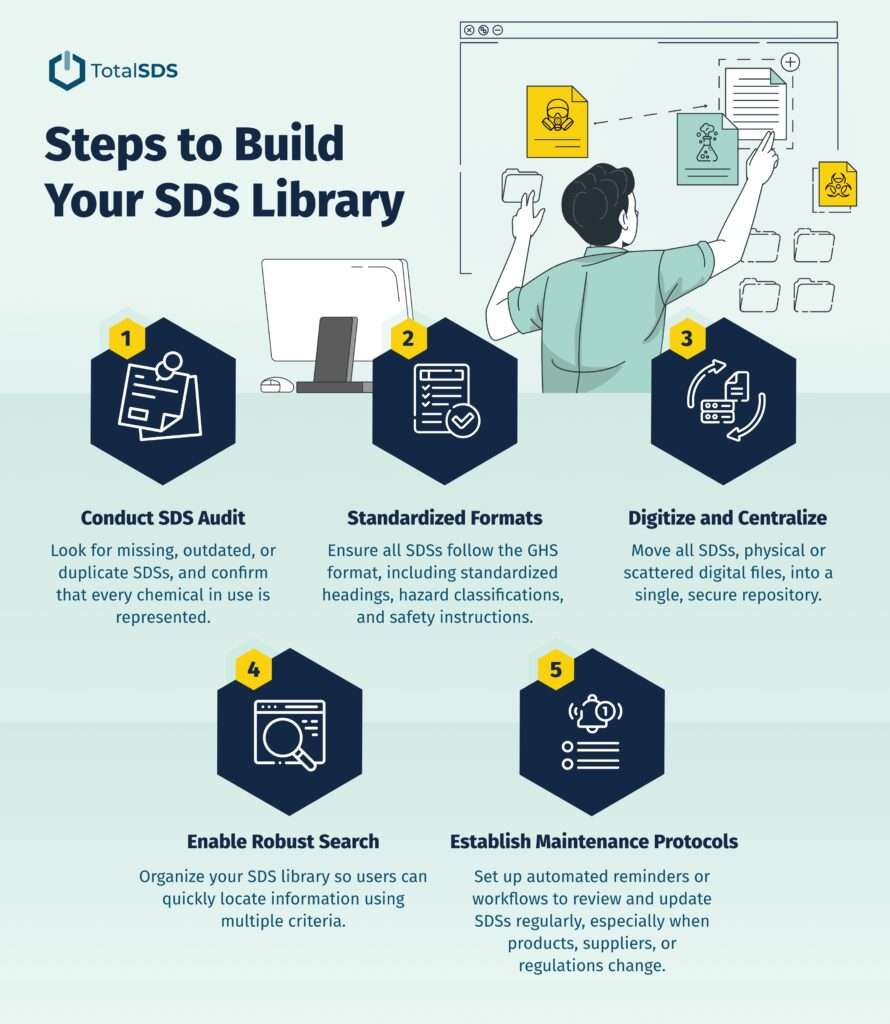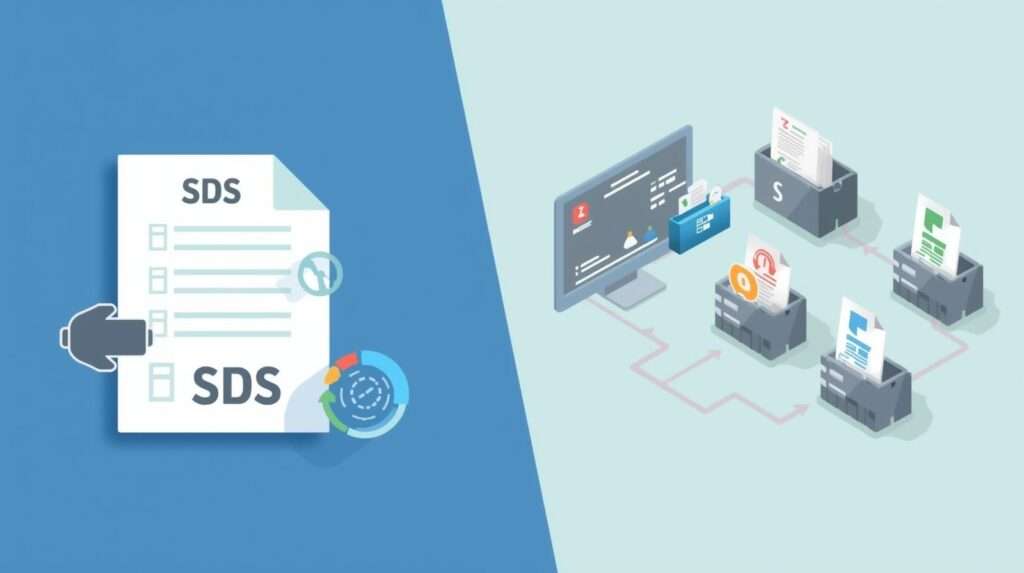In today’s regulatory environment, a well-organized Safety Data Sheet (SDS) library is more than just a compliance checkbox; it’s an essential part of protecting employees, ensuring operational efficiency, and safeguarding your organization from costly penalties. Yet many companies still struggle with SDS management, relying on outdated filing systems or scattered digital documents that make quick retrieval nearly impossible.
A modern SDS library should be both compliant and searchable, giving your team the ability to access accurate chemical safety information instantly. Building such a resource requires careful planning, ongoing maintenance, and the right tools to support your compliance efforts.

Understanding SDS Compliance Requirements
Under OSHA’s Hazard Communication Standard (HazCom 2012), aligned with the Globally Harmonized System (GHS), employers must ensure that SDSs are readily accessible to workers for every hazardous chemical in the workplace. These SDSs must be accurate, up-to-date, and presented in a consistent format that meets regulatory guidelines.
Noncompliance can have significant consequences. Missing SDSs, outdated hazard information, or poor organization can result in fines, reputational damage, and most critically, safety risks to employees.
A compliant SDS library ensures that hazard information is available at the moment it’s needed, whether for routine tasks, training, or emergency response.
Common Challenges with SDS Libraries
Even organizations with dedicated EHS teams and strong compliance programs can run into difficulties maintaining a robust SDS library. The sheer volume of products, frequent regulatory updates, and decentralized operations often create gaps in accuracy and accessibility. Without a consistent management strategy, an SDS library can quickly become outdated or disorganized, undermining both compliance and safety.
Some of the most persistent challenges include:
- Fragmented storage – SDSs spread across multiple folders, departments, or locations.
- Limited search capabilities – Difficulty locating an SDS by product name, CAS number, or hazard classification.
- Version control issues – Outdated sheets remaining in circulation alongside newer versions.
- Time-intensive updates – Manually replacing or revising SDSs when products change or regulations update.
Addressing these challenges isn’t just about convenience. It’s about reducing risk. Disorganized or outdated SDS libraries can slow response times during emergencies, increase the likelihood of noncompliance during audits, and put employees in harm’s way. Organizations that invest in centralized, searchable, and actively maintained SDS systems set themselves up for better safety outcomes, smoother inspections, and more efficient operations.
Essential Features of a Compliant, Searchable SDS Library
A high-performing SDS library is more than just a digital filing cabinet. Think of it as a dynamic, organized system that supports compliance, empowers employees, and ensures critical safety information is never more than a few clicks away. In many organizations, the difference between a compliant, well-functioning SDS library and a disorganized one comes down to the underlying features and functionality.
The most effective SDS libraries share several core attributes:
- Centralized storage in a secure, cloud-based system – Housing all SDSs in a single, protected repository eliminates the confusion of multiple storage locations and ensures consistent access to the latest information.
- Advanced search filters – Robust search functionality allows users to find SDSs by CAS number, product name, manufacturer, hazard classification, or keyword, saving valuable time during training, audits, or emergencies.
- Employee accessibility from any location or device – Remote and mobile access ensures that employees in the field, on the production floor, or at satellite sites can access SDSs without delay.
- Annual SDS update sourcing with a clear change history – Built-in version control safeguards against outdated SDSs being used, while a transparent change log supports audit readiness.
- Integration with SDS authoring tools – Seamless connection to authoring software allows for direct updates when formulations or regulatory requirements change, eliminating the need for repetitive data entry.
When these features are in place, your SDS library transforms from a static collection of documents into a living compliance resource – one that not only meets regulatory expectations but actively supports safety culture. This kind of system ensures that hazard communication is accurate, immediate, and dependable, even as products and regulations evolve.
Steps to Build Your SDS Library
Creating a compliant and searchable SDS library is not just an administrative task, it’s a strategic process that ensures safety, regulatory compliance, and operational efficiency. Breaking it into clear, actionable steps can help organizations streamline implementation and maintain a living, accurate resource for employees and stakeholders.
1. Conduct an SDS Audit
Begin by reviewing your existing SDSs to identify gaps or redundancies. Look for missing, outdated, or duplicate SDSs, and confirm that every chemical in use is represented. This foundational step prevents compliance violations and establishes a clear baseline for your library.
2. Standardize Formats
Consistency is key for both readability and regulatory compliance. Ensure all SDSs follow the GHS (Globally Harmonized System) format, including standardized headings, hazard classifications, and safety instructions. Standardized formatting makes it easier for employees to understand and use SDSs during training or emergencies.
3. Digitize and Centralize
Move all SDSs, physical or scattered digital files, into a single, secure repository. Cloud-based systems allow employees across locations to access information instantly, reduce the risk of lost documents, and create a single source of truth for compliance.
4. Enable Robust Search
Organize your SDS library so users can quickly locate information using multiple criteria: CAS number, chemical name, manufacturer, hazard class, or keywords. Advanced search functionality reduces the time spent hunting for documents and ensures the right information is available when it’s needed most.
5. Establish Maintenance Protocols
An SDS library is not static; it requires ongoing attention. Set up automated reminders or workflows to review and update SDSs regularly, especially when products, suppliers, or regulations change. Maintenance protocols ensure that the library remains accurate, current, and audit-ready.
How TotalSDS Manager Streamlines the Process
Managing an SDS library manually can be labor-intensive. This is where technology can make an immediate impact. TotalSDS Manager, offered by TotalSDS, provides organizations with:
- Centralized, cloud-based storage accessible to all authorized team members.
- Powerful search functionality for instant retrieval of SDSs by CAS number, chemical name, or hazard category.
- Integrated authoring capabilities for creating and updating SDSs in compliance with GHS and OSHA standards.
- Annual SDS sourcing updates to ensure only the latest, most accurate SDSs are available.
By combining SDS library organization with compliance automation, SDS Manager reduces administrative burden and enhances workplace safety.
A Smarter Path to SDS Compliance
An SDS library should be more than a regulatory requirement. It should be a tool that empowers your team, reduces risk, and ensures accurate safety information is always at hand. By centralizing, standardizing, and enhancing search capabilities, organizations can transform SDS management from a reactive chore into a proactive safety asset.
For companies seeking to build or modernize their SDS library, solutions like SDS Manager and SDS Authoring offer a seamless way to integrate compliance, efficiency, and accessibility into a single system.


